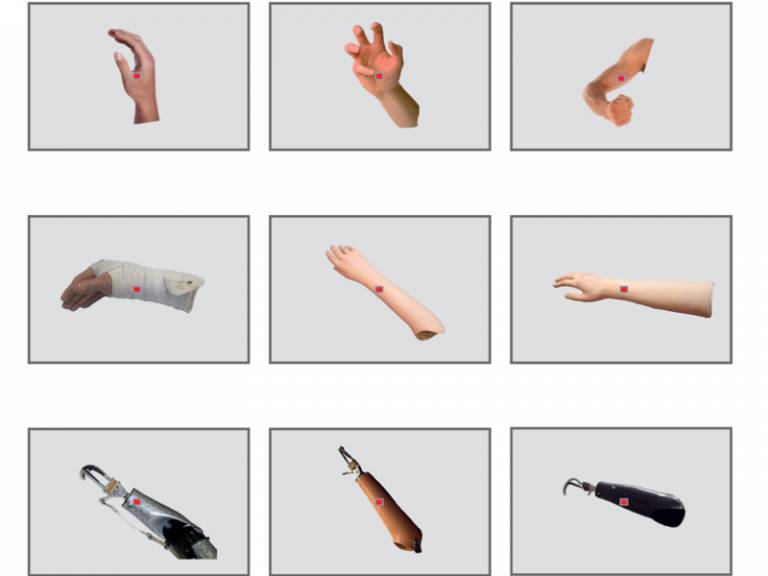Prosthetic limbs represented like hands in brain
9 March 2018
The human brain can take advantage of brain resources originally devoted to the hand to represent a prosthetic limb, a new UCL-led study concludes.

Among people with only one hand, the brain area that enables us to recognise hands can also recognise a prosthetic hand, particularly among those who use a prosthesis regularly, according to the new Brain paper.
The study provides the first account of how artificial limbs are represented in the brains of amputees.
"While the use of a prosthesis can be very beneficial to people with one hand, most people with one hand prefer not to use one regularly, so understanding how they can be more user-friendly could be very valuable," said the study's lead author, Dr Tamar Makin (UCL Institute of Cognitive Neuroscience).
"If we can convince a person's brain that the artificial limb is the person's real limb, we could make prostheses more comfortable and easier to use."
The study included 32 people with one hand - half of whom were born with one hand and half had lost a hand due to amputation - alongside 24 people with two hands, used as a control group, most of whom were family or friends of the people with one hand. The participants were shown images of prosthetic hands (including photos of their own prostheses) as well as real limbs. A functional magnetic resonance imaging (fMRI) scan was used to assess the participants' neural responses.
Within the visual cortex of the brain is an area that enables people to recognise hands. This area displayed a stronger response to images of prostheses among the one-handed participants, compared to the controls, particularly among those who used a prosthesis most frequently in their daily lives. This part of the brain also responded to images of prostheses that are functional but do not look like a hand, such as a hook prosthesis.
The researchers also investigated the connectivity between the visual hand-selective area and the area of the sensorimotor cortex which would be expected to control the missing hand.
They found there was better connectivity between these two brain areas in those people who used their prostheses regularly.
"Our findings suggest that the key determinant of whether the brain responds similarly to a prosthetic hand as it does to a real hand, is prosthetic use. As many of our study participants lost their hand in adulthood, we find that our brains can adapt at any age, which goes against common theories that brain plasticity depends on development early in life," said the study's first author, Fiona van den Heiligenberg (UCL Institute of Cognitive Neuroscience).
The researchers say their findings offer hope, as they have not found clear neural barriers to representing a prosthesis as a body part.
"Logically I know my prosthesis is not my missing hand - it's a tool, it's a new sensation and I accepted that. The more I use my prosthesis, the more I feel like it becomes a part of me," said Clare Norton, a study participant who has had one hand amputated.
"We think the ultimate barrier is simply how much you use the prosthesis," said Dr Makin.
"To me this is natural, having one hand is how it's always been. The prosthesis is part of me, I don't regard it as an addition - I consider it a hand," said another study participant, John Miller, who was born with only one hand and regularly uses his prosthesis.
The researchers say their findings could provide new insights to guide rehabilitation strategies as well as prosthesis design, and potentially guide other types of augmentation technology as well.
The study was conducted by researchers at UCL and the University of Oxford, in collaboration with researchers from the Hebrew University of Jerusalem, the University of Western Ontario and Radboud University Nijmegen. The study was funded by Wellcome, the European Research Council, the Royal Society, the Cogito Foundation, and the Natural Sciences and Engineering Research Council of Canada.
Links
- Research paper in Brain
- Plasticity Lab led by Dr Tamar Makin
- Dr Makin's academic profile
- UCL Institute of Cognitive Neuroscience
- Also by Dr Makin: Brain's "hand area" used by other body parts in people born with one hand
Image
- Images used in study. Top row: real hands, middle row: passive (cosmetic) prostheses, bottom row: active prostheses (Credit: F. van den Heiligenberg et al)
Media contact
Chris Lane
Tel: +44 (0)20 7679 9222
Email: chris.lane [at] ucl.ac.uk
 Close
Close

